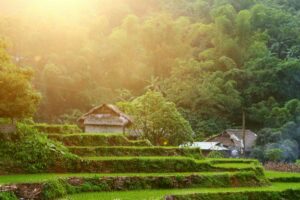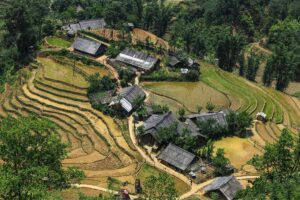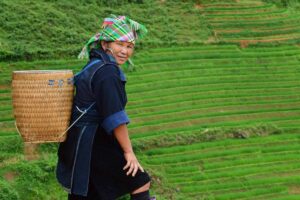Lao Chai Village, nestled in the Muong Hoa Valley of northern Vietnam, is a must-visit destination if you’re looking for an authentic Sapa experience that combines cultural immersion with the stunning natural beauty of the region. Located just a short 7 kilometers southeast of Sapa town, Lao Chai is the perfect place to unwind, trek through breathtaking landscapes, and experience the warmth of a homestay with local families.
About Lao Chai Village
Location
Situated in the northwest region of Vietnam, Lao Chai Village is part of the picturesque Muong Hoa Valley. This serene location is adjacent to Ta Van Village and is easily accessible from Sapa, making it a popular spot for visitors seeking to explore the natural beauty and cultural richness of the area.
Ethnic Groups: A Tapestry of Traditions
Lao Chai Village is a mosaic of diverse ethnic groups, primarily the Black Hmong, but also the Giay and Red Dao people. Each group brings its unique traditions and lifestyle to the village, creating a vibrant cultural landscape.
Black Hmong
The Black Hmong are known for their intricate embroidery and distinctive dark clothing adorned with colorful patterns. Their houses are typically made of wood and are designed to blend seamlessly with the natural surroundings. The Hmong community primarily engages in agriculture, growing rice and corn on terraced fields that have been cultivated for generations.

Giay
The Giay people, recognizable by their simpler, yet brightly colored clothing, live in stilt houses that offer protection from flooding. Their primary occupation is also farming, but they are known for their skill in crafting bamboo items and other traditional handicrafts.
Red Dao
The Red Dao are distinguished by their red headscarves and elaborate silver jewelry. They live in wooden houses and sustain themselves through farming and herbal medicine, a knowledge passed down through generations.
The village
Lao Chai Village is a picturesque haven surrounded by stunning terraced rice fields and the meandering Muong Hoa stream. The landscape is truly a sight to behold, especially during the rice planting and harvesting seasons when the fields transform into a sea of vibrant green or golden hues.
The village itself is a maze of narrow pathways winding through clusters of traditional houses, creating a charming and intimate atmosphere. As you wander through the village, you’ll encounter friendly locals going about their daily routines, children playing in the fields, and artisans showcasing their crafts.
Keep in mind that there’s a small entrance fee to the village, which helps support the local community and maintain the roads and bridges that connect Lao Chai to the outside world.
Highlights of Lao Chai Village
1. Views on the terraced rice fields
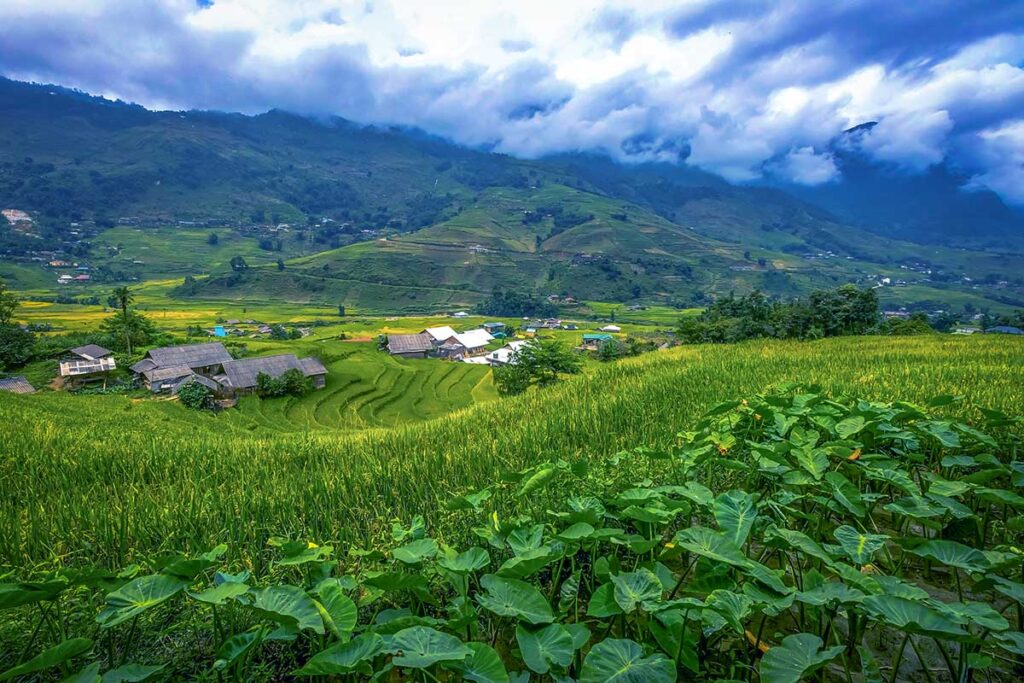
Lao Chai Village boasts some of the most breathtaking terraced rice fields in the Sapa region, with some of the highest and largest terraces you’ll find.
- From March, you’ll see local ethnic groups preparing the fields with water buffaloes.
- April and May bring the watering season, turning the fields into vast, reflective mirrors.
- In June, green sprouts begin to emerge, leading to lush green fields in July and August.
- By September, the fields turn a golden yellow, offering the most spectacular views as the locals harvest the rice.
Along the main road, you can enjoy panoramic vistas of the entire village and its surrounding rice terraces.
2. Exploring ethnic minority life
Immerse yourself in the daily life of the Black Hmong, Giay, and Red Yao people as you wander through the village, observing their traditional customs and activities. You might even have the opportunity to witness a traditional event like the Root Poem festival or the festival of fieldwork, offering a deeper understanding of their rich cultural heritage.
3. Trekking destination
Lao Chai Village is a premier trekking destination in Muong Hoa Valley, located conveniently close to Sapa. The trekking routes offer stunning views of terraced rice fields, lush forests, and traditional ethnic villages. Along the way, you’ll encounter breathtaking landscapes, picturesque valleys, and the vibrant life of the local communities.
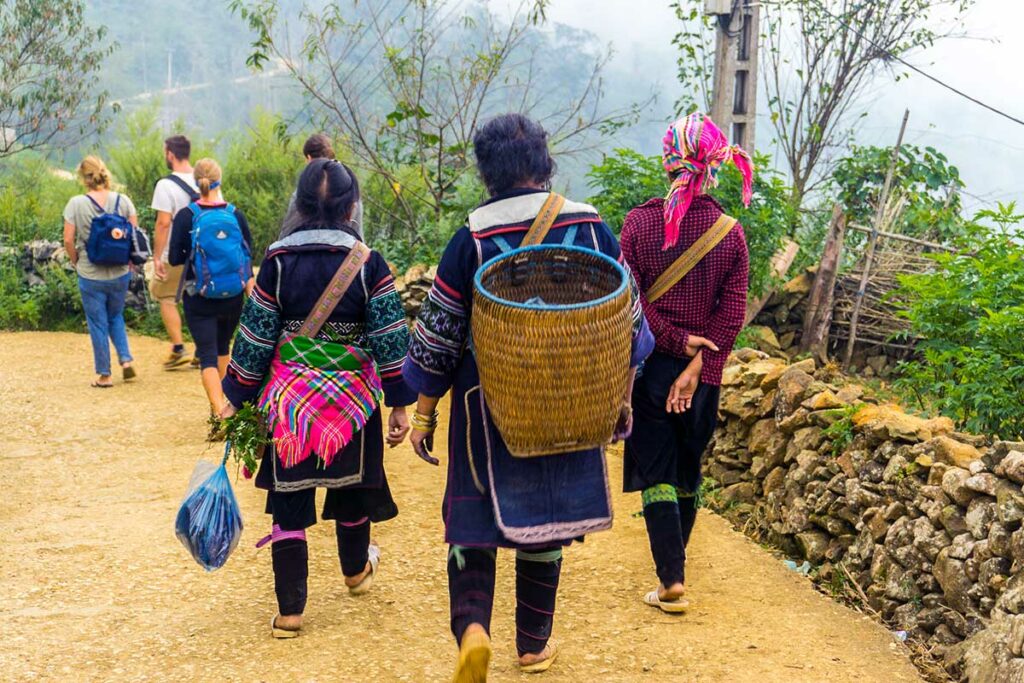
While Lao Chai is a popular trekking spot, not everyone prefers the beaten path. For those seeking a more secluded experience, we at Local Vietnam can design tours that explore less-marked trails. These routes still allow you to enjoy the beauty of Lao Chai but with fewer tourists, providing a more intimate experience. Additionally, we offer treks in other parts of Muong Hoa Valley, which have less big terraced rice fields, but are less touristy and still offer stunning views.
4. Homestay experience
Staying overnight in a homestay in Lao Chai Village is an authentic way to experience local life. Homestays range from basic, offering a truly authentic experience with communal living spaces, to more comfortable options with private rooms and modern amenities.
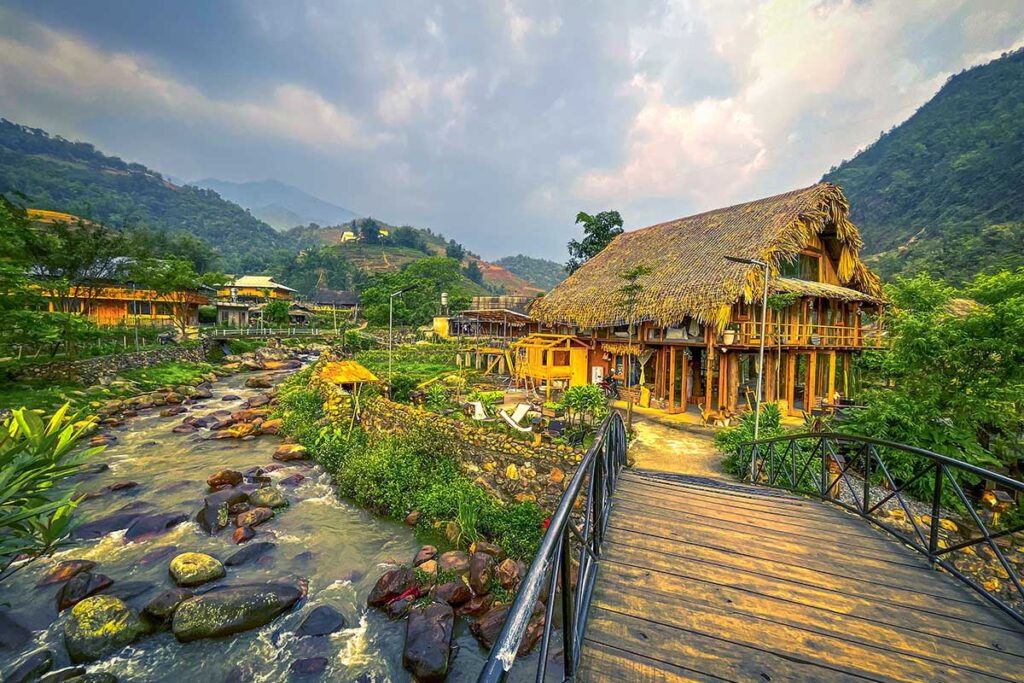
A homestay can be combined with trekking tours, allowing you to spend the first day on the popular trail from Sapa to Lao Chai, and the second day exploring more off-the-beaten-path routes further down the valley. This combination ensures you see the stunning terraced rice fields and enjoy a more secluded, authentic experience.
5. Shopping souvenirs
The ethnic minorities in Lao Chai Village are known for their exquisite crafts. Many locals sell handmade items such as textiles, embroidery, and bamboo products to support their families. Purchasing these crafts not only provides you with a unique souvenir but also helps support the local economy.
The Black Hmong are particularly known for their intricate embroidery and textiles, while other groups offer a variety of handcrafted items like baskets, jewelry, and wood carvings.
6. Enjoy local ethnic dishes
No visit to Lao Chai Village is complete without sampling the local cuisine. The village offers a variety of traditional dishes, with ingredients sourced from local gardens. Popular dishes include hand-carried piglets, five-colored sticky rice, Thang Co, and various local wines such as corn wine and glutinous rice wine. Sharing a meal with locals, especially during a mild day with a table full of scrumptious dishes and a glass of local wine, is an experience not to be missed.
How to get there
Lao Chai Village is conveniently located just 7 kilometers southeast of Sapa town, making it easily accessible by various means of transportation. The journey takes approximately 15-20 minutes by car or motorbike, depending on the route and traffic conditions. The village can be reached via the scenic Muong Hoa Road, which offers stunning views of the surrounding valley.
By trekking tour
Joining a trekking tour is the easiest way to visit Lao Chai Village. Tours typically arrange everything for you, including transportation and accommodation. Some tours start trekking from Sapa, following popular but stunning trails, while others may drive you to Lao Chai to skip the more touristy parts and continue from there on more secluded trails. Multi-day treks, including overnight stays in homestays, are also available, ensuring a worry-free experience as all logistics are handled for you.
By taxi
Lao Chai Village is accessible by taxi from Sapa, costing around 100,000 to 120,000 VND (approximately $4-5 USD). Taxis usually drop you off at the village entrance, requiring a short walk to reach your destination.
Alternatively, motorbike taxis are available for 60,000 to 100,000 VND ($2.50-4 USD), which can take you directly to your homestay but are less suitable for carrying large amounts of luggage.
Renting a scooter
For those with driving experience, renting a scooter in Sapa offers a scenic and flexible way to reach Lao Chai Village. The drive along Muong Hoa Road provides beautiful views of the valley and opportunities to stop for photos or visits to other villages. While a license is not strictly required for renting a scooter, we recommend this option only for experienced riders with valid licenses, as mountain driving can be challenging and insurance may not fully cover inexperienced drivers.
Homestays in Lao Chai Village
Staying in Lao Chai Village
Lao Chai Village is the perfect place to find accommodation around Sapa. Most of the accommodations here are homestays. Although the village attracts a significant number of tourists, it retains an authentic charm and offers a peaceful alternative to the often crowded Sapa town, which is filled with big hotels. Staying in Lao Chai provides a completely different experience, one that is more immersive and reflective of local life, and we highly recommend it over staying in Sapa town.
What to expect from a homestay
From basic to more comfortable homestays
Don’t expect luxury when staying in Lao Chai, but you will find a range of homestays, from basic to more comfortable ones. Some homestays offer modern amenities like Wi-Fi and private rooms, providing a bit more comfort. The basic homestays, while offering fewer comforts such as hard mattresses and dorm-style rooms, provide a more authentic experience. This type of accommodation gives you a great insight into local culture and is an experience you will never forget.
Standards for each homestay
Regardless of whether you choose a basic or more comfortable homestay, each one is required to have western-style toilets, showers, and mosquito nets. This ensures a certain level of comfort and hygiene for all guests.
Family dinner
In Lao Chai Village, there are hardly any real restaurants, so most meals are taken at your homestay. This is another amazing experience as you can watch how the local family cooks over an open fire before sharing a traditional dinner with them. Often, the host invites guests to drink rice wine, which is a special experience. However, you can kindly refuse if you prefer not to drink.
Recommended Homestays in Lao Chai Village
- Sapa Clay House – Mountain Retreat: Offers private rooms with modern amenities and stunning views of the terraced fields.
- Tavan Chopai Homestay: Known for its friendly hosts and comfortable accommodations with Wi-Fi and private rooms.
- H’mong Mountain Retreat: Provides a more rustic, authentic experience with basic facilities and communal dining.
Tips for visiting the village
- Do not give candy or money to children: Instead, consider giving them books or pencils, which are more useful.
- Ask for permission to take photos of people to show respect for their privacy.
- Avoid standing in the rice fields as they are the livelihood of the local people.
- Best times to visit: March, April, May, September, October, and November for the best weather, and July to early September to see the rice fields, though this is the rainy season.
- Handling local sellers: Some locals may follow you to chat and try to sell their products. If you are not interested, a friendly “No” will suffice, and they will eventually stop following you.
Other Villages to Visit
- Ta Van Village: Known for its Giay and Red Yao communities and beautiful rice terraces.
- Ban Ho Village: Home to the Tay ethnic group and a picturesque waterfall.
- Cat Cat Village: A popular tourist spot with Hmong cultural displays and a scenic waterfall.
